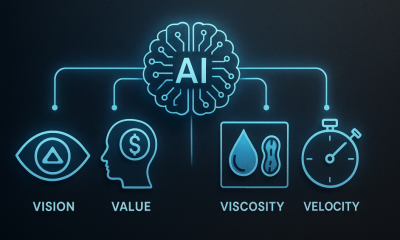Thought Leaders
How AI Is Transforming Enterprise Communications

Last quarter, a friend stepped into a new leadership role at a mid-sized tech company. She was responsible for a key account that had suddenly gone quiet.
“We had a long-standing relationship,” she told me, “but I can't figure out where things started slipping. The last notes from the account manager are in his notebook. He left months ago. There are scattered emails and WhatsApp threads, but no one has the full picture.”
She's not the first to share that story.
In most organizations, communication is fragmented across too many channels to be effective. Instead of living in one system, it's scattered across inboxes, personal notes, chat threads, voice messages, and meeting recordings. Each fragment lives in its own silo, making it nearly impossible to see the whole picture. Critical conversations that shape deals, decisions, and delivery often get buried and become inaccessible when needed most.
This is where AI-powered Communication Intelligence comes in. By capturing, connecting, and analyzing conversations across every channel, enterprises can finally turn communication from a reactive function into a proactive source of insight and advantage.
Why Now?
For decades, most communication data lived in compliance archives; calls recorded, emails logged, and interactions stored “just in case” of an audit. But today, the scale and complexity of enterprise communication have changed dramatically.
As the 2024 Work Trend Index reflects, the use of generative AI among knowledge workers has nearly doubled in six months, with 75% of them using it today. Organizations are increasingly embedding AI deeply into workflows, not just as spin-ins, but as real-time agents. Advanced enterprise strategies, such as the emerging agentic AI systems, are beginning to form the backbone of how companies operate.
Meanwhile, businesses that streamline employee communications through AI are already seeing results; one data-driven enterprise saved over $100 million annually by reducing communication overload.
AI is transforming this picture. Instead of being stored in silos, conversations across WhatsApp, Microsoft Teams, Slack, Zoom, SMS, and email can now be unified, indexed, and analyzed by machine learning models. The result: communication shifts from archival data to operational intelligence that drives workflows, customer relationships, and business outcomes.
From Compliance to Intelligence
Aggregation is just the first step. A centralized archive of calls and messages without analysis is like a warehouse of untagged boxes. The real value comes from turning that archive into intelligence:
- Summarize meetings and threads in real time
- Extract tasks and follow-ups from calls or chats
- Identify sentiment trends to surface risks or opportunities
- Provide early warnings when communication or relationships weaken
These structured insights transform static archives into operational intelligence, fueling proactive decisions and accountability throughout the enterprise. We're not far from the moment when a company can ask, “What are our clients most concerned about this quarter?” and get an answer based not on anecdote or quarterly surveys, but on actual conversations, at scale.
Again, the ability to extract that kind of signal from unstructured communication has changed the role of enterprise messaging systems. They're no longer just channels; they're datasets.
Mapping Relationships With AI
One high-impact application is relationship mapping. Large organizations often rely on tribal knowledge to understand relationships. AI changes this by illuminating who communicates with whom, how often, and about what, regardless of platform. This builds an accurate map of influence and a strategic advantage for account planning, coverage models, and knowledge management, replacing guesswork with data-backed clarity.
Persona profiling, another type of mapping, involves understanding how individuals communicate and what kind of information they prefer. Do they favor concise updates or detailed briefs? Are there early signs of disengagement in their tone or the frequency of their responses? When done ethically, this approach has significant potential for enhancing collaboration, customer success, and leadership development.
Closing the Loop: From Insight to Action
AI demonstrates its true potential when it fuels action. Modern systems can recommend follow-ups, identify missed commitments, suggest appropriate tone or phrasing for sensitive messages, and highlight internal best practices. This makes workflows visible, measurable, and continuously improvable. Also, effective patterns from high-performing teams can be modeled and shared.
The Governance Layer
For regulated or high‑risk industries, AI‑powered Communication Intelligence strengthens the guardrails that protect them. The same systems that highlight sentiment shifts or missed tasks can also flag compliance issues, verify facts, and create immutable records across informal channels. In practice, this means organizations gain both operational insight and stronger governance in a single layer.
Done right, Communication Intelligence is about transparency and alignment, not surveillance. It ensures that critical conversations don't occur off the record and that companies maintain oversight without interrupting the natural flow of work.
The strategic value of AI-enabled compliance is further underlined by the EU's landmark Artificial Intelligence Act, which came into full force on August 1, 2024, and mandates risk-based safeguards such as transparency, high-risk conformity assessments, and traceability for AI systems, setting a global benchmark for trustworthy AI governance.
The Next Paradigm
What excites me most is the mindset shift that is currently taking place. Previously, we treated communication as a reactive function, responding to emails, answering calls, and replying to messages. Now, communication is becoming strategic. It is increasingly viewed as a core dataset, providing valuable insights into customer behavior, team dynamics, operational signals, and cultural indicators.
This change does not replace human judgment; instead, it amplifies it. It helps every employee become more informed, responsive, and aligned, eliminating the need to sift through inboxes or reinvent the wheel in every conversation.
We're still at the beginning. But the shift from fragmented messaging to unified, intelligent communication will be one of the defining enterprise transformations of this decade.












